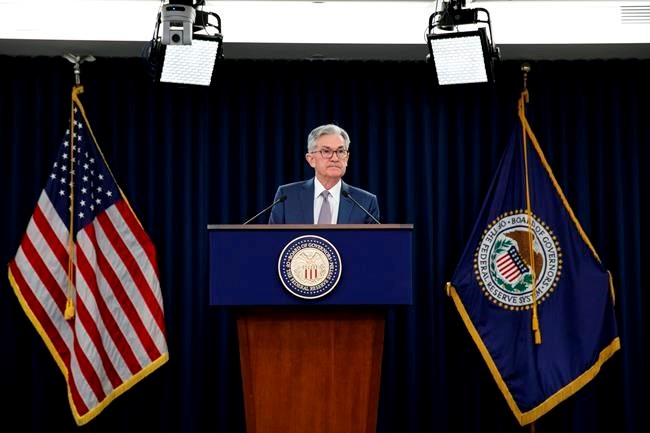WASHINGTON — The Federal Reserve has largely calmed turbulent financial markets. Yet a far tougher task remains: Helping rescue an economy and job market that appear to be free-falling into the worst catastrophe since the Great Depression.
Fed policymakers will meet Tuesday and Wednesday against a backdrop of dismal data: More than 26 million Americans have applied for unemployment benefits since the coronavirus forced widespread business closures. Retail sales have dropped by a record pace. Home sales have plunged.
In the meantime, inflation has started to fall amid the collapse in economic activity and is sure to sink further below the Fed's 2% target level. With beleaguered hotels, airlines and retailers slashing prices, inflation could fall to 1% or less by year's end. That poses another problem for the Fed: Declining prices can eventually lead consumers to delay spending, thereby slowing the economy further.
In response, the Fed has slashed its benchmark interest rate to near zero in two emergency moves and launched an alphabet soup of lending programs — nine in total — to pump cash into financial markets. The central bank has also bought about $1.4 trillion in Treasury securities to ensure that banks can swap Treasurys for cash and keep rates low.
Chairman Jerome Powell isn't expected to announce any major new initiatives when the Fed's meeting ends Wednesday. The central bank may provide more details on its lending programs and may also fill in some specifics about its Treasury-buying program, which is now essentially unlimited.
Economists will also look for any changes the Fed may make to where it stands on interest rates. At its meeting last month the Fed said it will keep rates at near zero “until it is confident that the economy has weathered recent events."
In the past, the Fed has sometimes set a time frame for future rate hikes, and in other cases has set out conditions, such as the unemployment rate falling to a certain level. But few analysts forecast anything specific Wednesday. Economists at Bank of America said they expect the central bank to simply acknowledge that rates will remain ultra-low for “an extended period.”
Powell will also likely face questions about the extraordinary actions the Fed has taken during this crisis, including unleashing lending programs that will directly aid individual cities and businesses, a step beyond its usual assistance to banks and credit markets. These interventions have exposed the central bank to concerns that it will inevitably
“That’s a very big step,” said Kathy Bostjancic, chief U.S. financial economist at Oxford Economics, a consulting firm. “The Fed hasn’t necessarily moved out of their lane, but they certainly have widened the lane.”
The Fed has also said it will buy up to $750 billion in corporate bonds, including riskier debt bearing higher yields — a “bit of a precarious step,” Bostjancic said, because the Fed normally avoids taking on credit risk.
Two weeks ago, as part of a $2.3 trillion lending program, the Fed said it would, for the first time, buy municipal bonds issued by state and local governments, up to $500 billion. It also unveiled a Main Street Lending Program, which will also for the first time lend $600 billion to medium-sized companies of up 10,000 employees.
The loans are intended to support mostly companies that are too large for the government's small business lending program, which targets those with fewer than 500 workers. Companies that borrow from the Main Street program must “make reasonable efforts” to retain their workers, the Fed says, and cannot repurchase their shares or pay dividends. The Fed has said it will disclose the recipients of its Main Street loans.
Still, most of these programs haven't formally launched. The Fed has yet to buy any municipal securities or corporate debt. Even so, just the announcements that it will do so have smoothed markets.
The announcements have also generated concerns about who will end up benefiting and who will not. As part of its new Municipal Liquidity Facility, the Fed said it would buy muni bonds from all 50 states and some large cities. But at first, only those cities with populations above 1 million and counties with populations of more than 2 million were eligible. That grouping included just 10 cities and 16 counties and excluded the 35 cities with the highest proportion of African-Americans, according to a report by the Brookings Institution.
Detroit and Atlanta, for example, failed to make the cutoff.
“The further the Fed pushes, the more issues it is likely to unearth,” said Mark Vitner, an economist at Wells Fargo.
On Monday, partly in response to such criticisms, the Fed expanded the facility to cover roughly 80 cities and more than 100 counties, by lowering the population cutoffs.
Vitner noted that the Fed's initial announcement of the facility helped reduce rates for muni bonds broadly, thereby supporting all issuers.
“What the Fed is doing is more holistic, and they are trying to support the whole economy," he said. “And they’re doing that by attacking specific pressure points.”
Christopher Rugaber, The Associated Press



